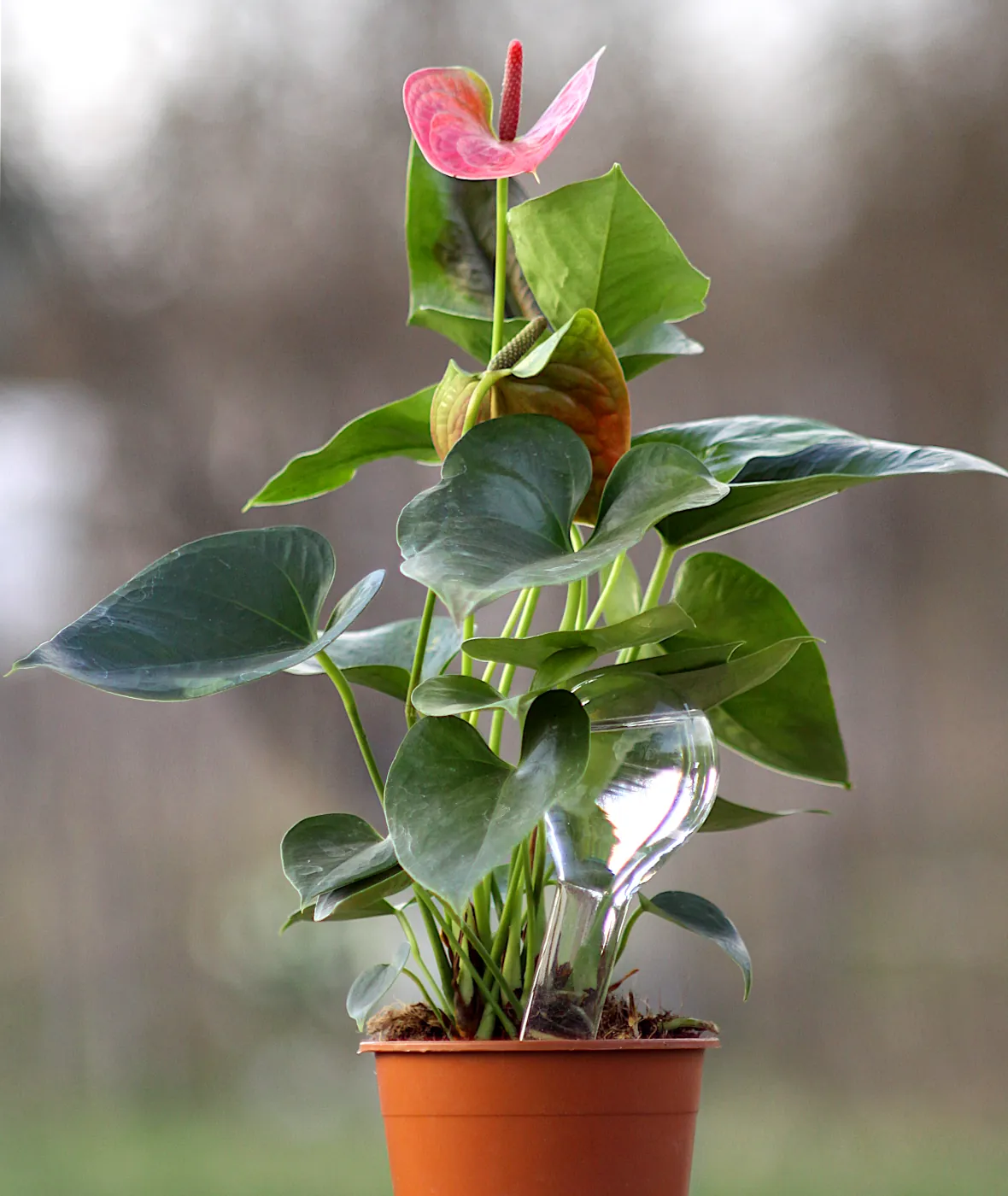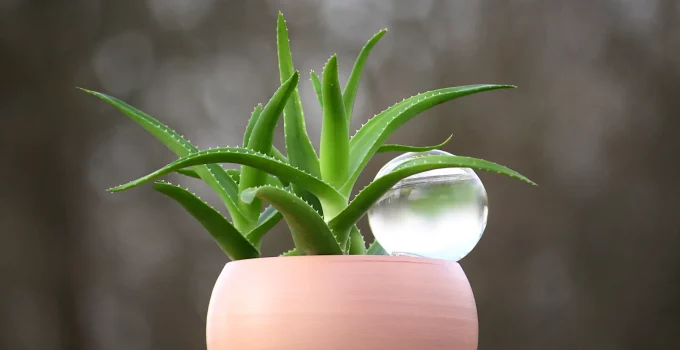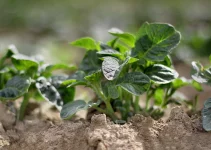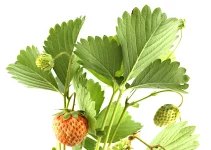In this guide on watering globes for plants, besides actually learning everything we should know about these tools for our plants, we’ll also tackle some important things.
Thus, we will discover if watering globes really work. And if they’re good for our plants.
Most importantly, we should establish if we can overwater when we’re using watering globes for plants and other important things like that.
Last but not least, I guess we should also cover some of the best watering globes for plants to see which tools we should buy if we decide to give these watering bulbs a try.
Basically, these bulbs that are filled with water are a simple, easy to use automatic watering system for our plants that can be used both indoors and outdoors.
Most boast that they can self-water our plants for up to 2 weeks. I would say that, realistically, we might get 4-7 days of self watering.
Since that’s the case, I’ll also talk about other options that we can choose if we’re looking for automatic watering methods.
Check out my recommendations for the best shelves for plants for both indoors and outdoors if you want to organize your pots beautifully.
Table of Contents
What are watering globes?

First of all, these things can be really pretty so I love that. Some of them really look like works of art or some pretty accessory for our beautiful plants.
Most are shaped like a relatively small balloon with a very long, narrow stem.
The capacity of these watering bulbs is pretty good. A capacity of 20 oz is really good. However, some of them will be a lot smaller than that.
The base looks like straws, the kind we use for our drinks, and on top we have a tiny, round shaped balloon.
Moreover, the balloon can be round or oval shaped, the shape really doesn’t matter.
Also, most watering bulbs are made of glass but there are also some made of plastic.
Those made of glass are mostly hand blown and they come in beautiful, mesmerizing colors. They’re beautiful to look at.
You might also come across some that are shaped like birds or other adorable animals.
Anyway, you pretty much understand what these tools are. There’s nothing really sophisticated about them really.
We get:
- a long stem through which we fill up the balloon on top
- the water also drips into the soil through the same long base
Thus, the base is stuck into the soil while the balloon on top holds the water for our plants. That’s the basic principle of using watering globes for plants, there’s nothing all that complicated about them.
Some watering globes will also come with a cleaning brush. This looks like the cleaning brush we get for glass drinking straws. Thus, if your package doesn’t include a cleaning brush for dirt and debris, then get a cleaning brush for glass straws.
How to Use Watering Globes for Plants

What I like about these self watering bulbs is just how easy they are to use. We must just follow a few quick steps, we’ll be done in a minute.
I also like that they’re quite affordable.
1. Make a hole in the soil
Make a hole in the soil to prevent the soil from clogging up the opening of the stem.
Use a pencil to make this hole because it resembles in size and shape the neck of these self watering bulbs.
2. Fill up the globe with water ¾ full
Don’t fill them up with water 100% full.
We should add about 80% water.
You have to have a bit of patience for this stage because the stem through which the water will flow to the globe that holds the water is quite narrow.
Once the globe is filled up with water, press your thumb on the opening to avoid spilling the water all over.
3. Stick the stem in the soil
Keep the watering globe with the balloon side up and stick the stem with the opening in the soil.
You don’t have to push the narrow base shaped like a drinking straw too deeply into the soil, just enough for the balloon to stay upright.
It can also be positioned at an angle, it doesn’t necessarily have to be perfectly straight.
It just has to be stable in the pot so that it doesn’t fall over.
If the watering globe isn’t stable in the soil and doesn’t stay upright, it will spill over from the pot, fall on the ground and break if it’s made of glass.
Since I’ve mentioned that we should push the stem into the soil just enough for the balloon to stay upright and fixed, it’s time to talk about something important that is crucial for our guide on how to use watering globes for plants.
Sometimes the stems of these tools are a bit too long. That might mean that we have to push these stems into the soil too deep in order for them to be stable.
But if the stems of watering bulbs are pushed too deeply into the soil that means that the water won’t reach the entire root system of our plants, which will mean that these watering globes might not really work.
Which also means that these self watering bulbs might work better in bigger pots with deeper plant roots.
How do watering bulbs work?
The water is held in the globes and water reaches the soil through the long, narrow stem whose opening is inserted into the soil.
Thus, our plants are watered automatically.
As the soil becomes dry, it releases oxygen into the stem of these globes. That in turn releases the exact amount of water the plant needs.
That means that we can go away on vacation and be reassured that our plants receive the water they need when they need it.
If you have plants in big pots, you might need to insert 2-3 globes into the soil.
The same goes if we’re away from home for a couple of weeks or more.
We can use them both indoors and outdoors.
We can use them for: houseplants, hanging plants, gardens, flowers, herbs, potted plants or patio plants.
Do they work well?
It depends on the plants you want to automatically water with these globes.
For example, I wouldn’t recommend them for plants that don’t need a consistent and constant water supply.
Thus, they can work well for plants who thrive in a constantly moist soil.
On the other hand, I wouldn’t recommend them for succulents that only need watering when the soil is at least 90% dry.
Cactus and similar succulents are a good example of plants that will not benefit from watering bulbs.
All in all, I would say that watering globes work if they’re used for plants that will benefit from an automatic irrigation tool that keeps the soil moist constantly, eliminating the danger of dry or over-watered soil.
Can we overwater with water globes for plants?
In theory, overwatering shouldn’t happen because the water should only be released when the soil gets sufficiently dry to need another dose of water.
Moreover, the size of these self watering bulbs is quite small, which can also prevent them from overwatering.
We can have self watering bulbs with a 20 oz capacity (600ml) but we must also take into account that we only fill them ¾ full with water or we fill them up about 80% full so their capacity is actually slightly smaller.
The conclusion is that I believe that self watering bulbs don’t cause overwatering.
But I also wouldn’t use them for plants that thrive in mostly dry soils, like cactus and some other succulents.
Before using self watering tools for plants we must always first understand the needs of our plants and then decide if those tools would work or not.
Best Watering Globes for Plants
Since we’ve already seen how to use watering globes for plants, I think we should also quickly cover some nice options that we can buy.
1. Wyndham House 3-Piece Watering Globe Set
This watering globe set of 3 pieces is very popular.
It’s also pretty affordable given that we pay for 3 pieces of watering bulbs.
Each is 12 inches long so I would say that these ones are very good for larger pots.
The bulb has a 3 inch diameter. It’s not very big so I would say that if you leave your house for 2 weeks, I recommend sticking 2 -3 of these self-watering bulbs in the soil.
They’re made from hand-blown glass and they look very beautiful, the colors are gorgeous.
2. Blazin’ Bison Indoor Plant Watering Globes
This manufacturer offers a few options to choose from, which can be nice.
First, we get to pick between a set of 2 globes or a set of 4 watering globes.
If you’re maybe not sure that these automatic watering tools might work well for your plants, you can just choose to buy the set of 2 to try it out.
We also get to choose a few different sizes: large, jumbo (size option only for the set of 2), small, and mushroom.
The mushroom one actually contains 4 watering globes that are shaped like some cute mushrooms instead of the usual balloon shape. They’re really cute and they measure 3.35 inches in diameter. They’re 12 inches high.
We get the same measurements for the classically, balloon shaped large globes.
Features
The Blazin’ Bison Indoor Plant Watering Globes are made of pretty glass. They’re made of hand-blown glass, which makes them a bit fragile. They have a long stem and a globe at the top that will be filled with water.
Moreover, the colors are beautiful and, unlike plastic bottle irrigation, these glass watering bulbs will look beautiful in our pots or in the garden.
The manufacturer mentions that these automatic watering tools are easy to fill with water.
This is where we have to disagree a bit. While filling them with water is not exactly difficult, it can take a bit of time because the stems of all watering globes are quite narrow.
Remember to fill them ¾ full or about 80% full. Don’t fill them up completely.
Also, make a hole into the soil for the stem to prevent the opening from getting clogged with soil.
We don’t get a cleaning brush. I recommend buying a cleaning brush for glass straws. The stems look pretty similar to glass straws.
3. Jitnetiy 3 Pcs Hand-Blown Glass Self-Watering Globes
Let’s talk about some of the most adorable self-watering globes for plants. These ones are absolutely gorgeous and so pretty.
We actually get to choose from 4 different designs.
There’s a clear bear set. This set only contains 2 pieces so it’s also pretty affordable.
The clear cat set contains 3 pieces and it’s among the most popular choices from this manufacturer.
We also get a clear dog set for the same price of the clear bear set. It also contains just 2 pieces.
Last but not least, there’s the stripe cat set of 3 pieces.
They’re all adorable so it’s hard to choose a favorite animal.
I guess my favorite is the clear cat set, if I had to choose.
Their capacity is not that big. Each watering ball holds 120ml of water so I wouldn’t rely on a single bulb to provide sufficient water for more than a few days.
4. 16pcs Plant Watering Gloves
This set is not my favorite because I don’t think that the quality is the best but they do have some things going for them.
First of all, we get the chance to buy 16 watering globes in one set.
Moreover, the whole set costs less than $15. This whole set of 16 pieces is 2-3 times cheaper than most sets of 4 pieces.
Given the cheap price and the number of pieces sold, I thought that it deserves a mention since we’re talking about the best watering globes for plants.
Features
While the set contains 16 pieces which is awesome, I must underline one feature.
These are small bulbs.
They measure 5.3 x 2 inches. So they have a 2 inches diameter which is indeed small.
On the other hand, I think that we can absolutely use them in smaller pots since their stems are not long at all.
Moreover, the smaller water capacity can make them a good choice for self-watering plants that are not big water lovers, like cacti and succulents.
Personally, I wouldn’t buy these for large containers.
Another feature to mention is that these watering globes are made of high-quality PVC.
Since they’re not made of glass, that means that we don’t need to be afraid of breaking them, which can be really nice.
Other automatic watering systems: plastic bottle irrigator
When I was little my mother had a more rudimentary approach to creating a drip irrigation system.
She used plastic bottles for automatically watering plants, which worked quite well. Plastic bottle irrigators are still used today, it’s not like people forget about them.
We talked about how to use watering globes for plants and we saw how easy it was.
But if you don’t want to spend money at all, then you can try making your own plastic bottle irrigators.
Just like the name suggests, we only need plastic bottles in order to make this automatic watering drip system.
If you’re tempted to try out this method, I recommend checking out this article because it contains a good guide on how to implement this system.
There are actually 3 ways in which we can use a plastic bottle irrigation system:
- Hanging the bottle above the plant – it is the hardest to implement but it’s also the one that has the potential to last longer because there is no soil to clog the holes in the bottle cap or in the bottle
- In-ground, upside down with the cap-end buried in the soil – most people prefer using this one because it’s simple, we just have to drill a few tiny holes in the cap of the plastic bottle and cut out the bottom
- Bottle buried to the cap, only the top of the bottle is sticking out of the soil – holes are poked all over the sides and bottom of a plastic bottle and then a sock is cramped into the bottle to absorb water and slowly leech it out to the roots as needed
Are self watering planters better?
Since we’re talking about how to use watering globes for plants, which is an automated watering system, we should also address another alternative: using self watering pots.
Self watering planters can work very well for a wide variety of plants, there’s no doubt about that.
Moreover, I also love the fact that we can buy a bunch of self watering planters for quite an affordable price.
There are plenty of self-watering container sets that are sold for affordable prices so they can be a reasonable option even if we have a lot of plants that we want to water automatically.
How do self-watering pots work?
For a more in-depth discussion on this topic, check out this article.
They use sub-irrigation to deliver water directly to the roots.
We pour water at the bottom of the planter, that’s where their reservoir is. Thus, they water from the bottom, while watering globes water from the top of the soil.
With self-watering planters, the soil and roots drink at their pace. When the reservoir is empty, we add some more water. It’s yet another simple system.
All in all, self-watering pots work for a wide variety of plants but, obviously, they are restricted to potted plants.
On the other hand, as we saw in this guide on watering globes for plants, we can use these automatic water tools both in the garden and for potted plants.




